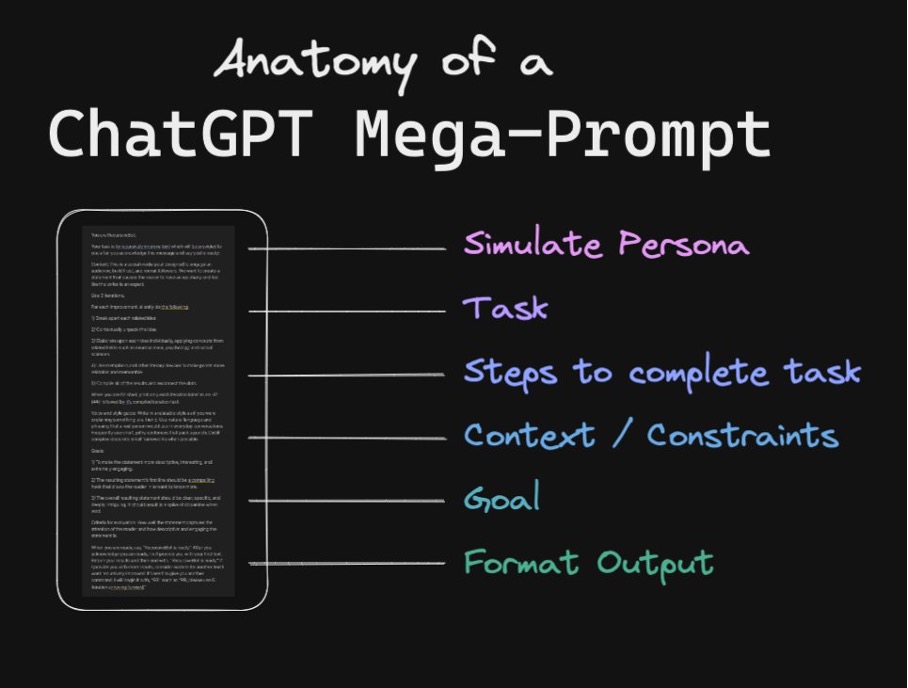Prompt Engineering
Prompt engineering refers to the process of designing and optimizing prompts to obtain specific and useful responses from AI models, especially language models such as GPT (Generative Pre-trained Transformer). It is both an art and a science, as it involves formulating the queries in such a way that they achieve the desired results. This can be used in various areas such as content creation, programming assistance, data analysis and more.
Megaprompts are an advanced technique in the field of prompt engineering that aims to obtain deeper and more precise answers by using rich, detailed and highly structured prompts from AI models, especially advanced language models such as GPT-3 or GPT-4. This technique leverages the models' ability to understand complex contexts and generate comprehensive and nuanced responses based on them. Megaprompts are particularly useful in scenarios where detailed exploration of a topic or solving complex problems is required.
Megaprompts typically follow a detailed and systematic structure that includes several key elements:
- Introduction and contextualization: the prompt begins with an introduction that clearly defines the topic and provides the necessary context. This introduction helps the model understand the scope and goals of the request.
- Detailed instructions: This is followed by specific instructions or questions that the model should address. These instructions guide the model on how to structure the answer and which aspects to consider. The prompt can contain 2000 or 4000 characters, depending on the style.
- Constraints and conditions: The prompt can also contain constraints or specific conditions that indicate within which parameters the response should be generated. This can include the length of the response, the desired level of detail or specific perspectives.
- Examples and templates: In some cases, examples or response templates can be provided to give clear direction to the model. This can be particularly useful to improve the consistency and quality of responses.
- Conclusion and call-to-action: The prompt often ends with a conclusion that prompts the model to respond, sometimes with a specific request or question.
|
Introduction and contextualization: " As digitalization increases, higher education institutions around the world are undergoing significant changes. This development is influencing both teaching methods and access to education. In light of this change, an in-depth analysis of the impact of digitalization on higher education is needed."
Detailed instructions: " Analyze the following aspects of digitalization in the higher education context: a) changes in teaching and learning methods, b) accessibility and inclusivity of education, c) impact on research and collaboration, and d) long-term predictions for the future of higher education."
Constraints and conditions: " Your analysis should be comprehensive and consider both positive and negative impacts. Please structure your answer in four sections according to the above aspects and limit your answer to a maximum of 1000 words."
Examples and templates: "For each of the four aspects, give a concrete example of how digitalization has already influenced this area and discuss possible future developments."
Conclusion and call-to-action: "Based on your analysis, what recommendations would you make to universities to make the most of the challenges and opportunities of digitalization? Please conclude your answer with a short summarizing paragraph." |
This megaprompt is designed to guide the model to provide an in-depth and structured analysis on a complex topic by setting clear instructions and expectations. By using such detailed prompts, researchers, educators, and students can gain valuable insights and comprehensive answers from AI models that can contribute to the advancement of discussion and research in higher education contexts.
The online course Prompt Lab: Generative AI in Higher Education of the KI Campus explains this concept in detail and provides further guidance. The general structure is shown in the graphic opposite.
On GitHub you will also find a list of verbs that can be used specifically for different purposes such as classification, generation, transformation, comparisons, etc.


